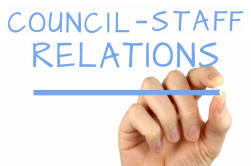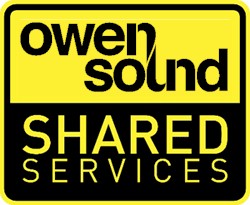Real Solutions to Solve Problems
|
Owen Sound Taxes
are $10.5 million higher than the average of the three primary comparator
municipalities and $6.5 million higher than Cobourg which is nearly
identical to Owen Sound in population, population-density and the number of
occupied dwellings.
Owen Sound spends $11 million more on delivering services, not including
Protective Services, than the average of primary comparator municipalities
in the study group and $3.8 million more than the municipality of Cobourg
which delivers nearly identical services. Table 10, below shows the
magnitude of the challenge in bringing Owen Sound Expenses in line with
similar municipalities. |
|

|
|
Table 10;
Changes Required to Restore Municipal Administrative
Competiveness |
Owen Sound’s total expenses, including protective
services, have been growing at a rate of $1.3 million per year since
201142. In 2011 Owen Sound’s total expenses were $40.1 million and in
2022 they were at $55.3 million. During this time Owen Sound’s
population reduced by 76 residents. Therefore population was not the
driving force behind this astronomical expense growth.
There are four areas that Council should focus on:
A. Increase Non-Taxation or
Ancillary Revenue,
B. Share Costs with Others,
C. Reduce and Tighten Up Support Services
D. Re-Align, Re-Organize and Re-Think
A. Increasing
Ancillary Revenues
Owen Sound generates only 49.5% of revenue
from ancillary resources while Cobourg generates 56.1% of its revenue from
non-tax sources. Owen Sound can increase its non-tax revenue by doing the
following:
1) Ancillary Business Department
Create an Ancillary Business Department and
hire a Director, with business development experience, on a five (5) year
renewable contract, reporting to the City Manager. The initial mandate
should be to increase ancillary revenues by 10% or $3.1 million over the
initial contract period.
2) Develop Profit Centers
Municipal operations are traditionally
composed of a number of cost-centers that provide needed services to
taxpayers. As a result the culture within city hall has traditionally been
focused on providing the best services money can buy. Well-meaning city
staff routinely focus on improving services to the community and searching
for opportunities to enhance the quality of services. Typically reducing the
cost of service delivery is not a priority.
A surprising discovery, when examining municipal expenses, was that two of
the municipalities in the study group had established Profit Centers.
Surprisingly, municipal Profit Centers are not all that uncommon in Ontario.
Not too far from Owen Sound, just down highway 21, is Bruce Telecom which is
a public utility that is wholly owned by the Corporation of the Municipality
of Kincardine. Kinecardine just recently sold this Profit Center and by
doing so added $32 million to its municipal coffers.
The most interesting Profit Center in the study group is Cobourg’s
Industrial Complex. A number of years ago Cobourg’s Council approved an
investment in Cobourg’s vacant industrial property. The annual amortization
expense for this investment in 2021 was $721,875.This turned out to be a
good investment given that the annual net revenue from Cobourg’s Industrial
Property is $2.1 million.
Cobourg’s second Profit Center is its Marina business which is generating
$53,959 in annual net revenue. Tillisonburg found an innovative way of
leveraging its surplus assets by leasing them instead of selling them. For
Example the Elliott Fairbairn Centre is a facility located on Earle Street
in Tillsonburg. It is owned by the town and is leased to the Province of
Ontario for the training needs of the Ontario Provincial Police.
Owen Sound can emulate Cobourg’s success by creating similar non tax-based
revenue streams. Instead of disposing of city assets the city should invest
in these assets and turn them into new revenue sources. Like Cobourg had a
few years ago, Owen Sound has surplus industrial land that could be
developed by the city and provide the city with a steady flow of revenue in
perpetuity. Serious consideration should be given to following Cobourg’s
success with its industrial park initiative by investing in city owned
industrial property.
There are similar opportunities
for developing profit centers in Owen Sound. For example, all surplus
assets, such as an unused building, should be offered for a long term lease,
instead of offering it for sale. Such action eliminates the potential
business’ need for capital to purchase the building and frees up resources
for investing in leasehold improvements. Leases for 15 to 25 year periods
should be offered, with options to renew. This would potential leaseholders
the opportunity to make sizable investments in leasehold improvements that
could be amortized over the lease period. This strategy will give the city
steady revenue for the life of the building in question
3)
Engage Staff and Encourage a Business Approach
In order to recognize revenue generation and cost saving opportunities staff
needs to adopt a ‘business approach’ as opposed to a, ‘municipal
administration approach’ when interfacing with city assets. This will
require a combination of education and incentives to change the culture.
One method of encouraging an ’entrepreneurial spirit’ in a municipal
environment is to establish a business-focused, Suggestion Awards Program.
The program should be open to both city staff and the general public and
reward successful ideas with the first two years net profits of the new
business venture. In the event of cost-saving suggestions the employee or
resident who made the suggestion should be awarded the net cost savings, up
to a maximum amount for each successful suggestion.
If implemented such a suggestion award program will encourage staff to think
differently and gradually change the culture at city hall. An example of the
type of thinking that should be encouraged is the idea I put forward last
year to reduce the cost of Transit. The idea involved improving ridership by
increasing peak-time service and reducing costs by partnering with local
school boards to reduce their student bussing costs.54
How to Fix Our Broken
Transit System
I’m sure that front line staff see inefficiencies in some areas of service
and have ideas on how to improve things. They just need to be encouraged to
put their ideas forward and providing a monetary reward for successful ideas
may be all it takes to begin the process of ‘Thinking Differently’.
B.
Share Costs with Others
1)
Cost Sharing Agreements for Recreation Facilities
Owen Sound residents have by far the lowest ability to pay high taxes yet
they are burdened with the full cost of providing services that many
residents living adjacent municipalities use on a regular basis. Neither
Georgian Bluffs nor Meaford residents contribute anything, beyond their user
fees, toward the maintenance of these regional facilities such as the
Bayshore, the Rec Centre and the Art Gallery.
Owen Sound has a population of 21,612 residents and occupies only 24 km2 but
is surrounded by Georgian Bluffs and Meaford which have a combined
population of about 22,585 and cover an area of 1,187 km2. Therefore it’s
understandable that residents of both Meaford and Georgian Bluffs would take
full advantage of Owen Sound’s attractions and recreation venues. The number
of Owen Sound residents filing income taxes on between 2018 and 2019 reduced
by 2.2% according to Statistics Canada 41. In all likelihood, wage earners
are just moving across municipal boundaries to reduce one of the growing
strains on their family finances – high Taxes and the high rents that result
from high taxes. After all, they can continue to enjoy everything that Owen
Sound has to offer, while living in Georgian Bluffs or just East of 28th
avenue in Meaford.
Given their relative populations, Owen Sound should only be paying for 48.9%
of the total cost of regional services, Georgian Bluffs and Meaford should
cover 25.2% and 25.9% of the cost respectively, including amortization
expense.
It was recently brought to my
attention that Owen Sound attempted to negotiate a cost sharing agreement
with Georgian Bluffs 10 years ago and failed. Given this I would recommend a
different approach. My approach would be to start this budget season by
publicly giving them notice that effective January 2025 neither the Rec
Center nor the Bayshore will be providing subsidized services to
non-residents due to current economic conditions. This will either prompt
them to open negotiations or not. Either way it will be a win for Owen
Sound. If they come to the table our position should be that Georgian Bluffs
and Meaford cover 25.2% and 25.9% of net costs respectively. If they don’t
open negotiations it will open new opportunities for these facilities.
As well as preserving existing
commercial contracts, this approach would allow for expanding commercial
services and ancillary uses at competitive rates, e.g. the Rec Center could
contract with a 3rd party fo r the bulk purchase of ice time etc. at market
value. If it comes to losing non-residents participation in programs, it
should not hurt the business. It could actually help the business by opening
new opportunities. This is where the Director of Ancillary Services comes in
to grow the business while protecting the original intent of the recreation
facilities to provide services to Owen Sound residents at a fair ticket
price.
One thing to keep in mind is
that these facilities do not exist to provide services to non-residents and
the status quo of Owen Sound taxpayers subsidizing recreation for
non-residents must end. Either way the potential reduction in expenses is
$1,981,452 x 0.511 or
$1,012,521.
2) Donate the Art Gallery Collection to the County
|
 |
|
The Jack Pine by Tom Thomson |
The Art Collection that is
currently under the control of Owen Sound was acquired from regional artists
and donors. It is therefore only fitting that the regional government take
possession of the collection and manage it on behalf of all County
residents.
The results of the last
community survey show that less than 8% of Owen Sound residents regularly
visit the Art Gallery. Hence, there will likely be little or no support
among Meaford or Georgian Bluffs taxpayers to share the cost of this
regional service. Therefore the only solution available to share the cost of
this service is to donate the collection to the County for control and
maintenance. This would better reflect the regional nature of the Collection
and would actually be more appropriate than it being exclusively under Owen
Sound’s control.
The same arguments used to justify uploading the Disability Committee to the
County apply in the case. The County already provides the region with a
cultural attraction in the Grey Roots Museum and Archives. So, adding the
Tom Thomson Art Gallery would centralize the Region’s cultural assets in a
single location. This would also better reflect the regional nature of the
Collection and the artists who contributed to it. Therefore, the County’s
stewardship of the Art Gallery would actually be more appropriate than it
being exclusively under Owen Sound control.
The current building housing the Tom Thomson Art Gallery could be offered
for lease to a new or existing business and thereby establishing Owen
Sound’s first Profit Center. I believe that this compromise solution is a
better option then what many are advocating which is to close the Art
Gallery and sell the collection so the proceeds could be used to reduce
taxes. From an Owen Sound taxpayer perspective it would reduce net expenses
by as much as $500,000 once the building lease revenue is considered. This
would represent a 1.6% reduction in taxes.
3) Expand Administrative Shared Services
Owen Sound is not maximizing the use of shared services with adjacent
municipalities to reduce the cost of administrative support.
Almost all Ontario municipalities share some services to some degree. There
is an excellent paper on this subject that I highly recommend. It is
authored by Zachary Spicer Institute on Municipal Finance & Governance and
published by the University of Toronto,
Linking Regions, Linking Functions:
Inter-Municipal Agreements in Ontario 53
|
|
Inter-municipal agreements are a growing part of
the governance landscape in Ontario's municipal sector. Past
research - mainly American - has shown that inter-local
agreements can overcome institutional deficiencies in
metropolitan governance and better provide for policy and
service Continuity ...
Zachary Spicer |
In this regard Owen Sound has a number of administrative services that can
be easily shared with the other Ontario municipalities either using a
portion of the existing employees from each of the municipalities or
contracting to the third party provider. Some good candidates for shared
services are Information Technology, Accounting and Payroll but there are
several others. High Speed Internet makes it possible for Owen Sound to
share services with any Ontario municipality. Therefore Owen Sound should
look beyond the Region to identify potential municipal partners.
C. Reduce - Tighten the Support Services Group
1)
Examine the Organization for Redundant Services
Before reaching out to other municipalities to share services, Owen Sound
needs to first examine its workforce to identify and eliminate the
duplication of services. For example, Owen Sound has two IT Managers and two
Corporate Services Managers. One IT Manager (Mark Giberson) and one
Corporate Services Manager(Bradey Carbert) report to the Director of
Corporate Services; while, one IT Manager (Christopher Hill) and one
Corporate Services Manager (Suzanne Bell-Matheson) report to the Chief of
Police. It just doesn’t make sense to have two separate Information
Technology Departments. All of Owen Sound’s Information Technology services
should be centrally managed. It may be convenient for Police Services to
have their own IT department but Owen Sound Taxpayers cannot afford to fund
the luxury of such redundant services. The fact that Police Services reports
to the Police Services Board and not the City Manager makes no difference
when it comes to administrative support services since all positions are
funded by the same global city budget. Council needs to direct that all
administrative support services, such as IT are centrally provided. We
cannot afford individual departments, including Police and Fire Services,
operating in silos and providing their own administrative support services
such as IT, HR and Corporate Services.
2) Investigate the Outsourcing of Some Support Services
An alternative solution to sharing selective support services with other
municipalities is contracting out services. For example, just as some
municipalities have chosen to outsource their Police Services, selective
support services such as Information Technology, Human Resources and Payroll
can also be outsourced. council should explore the possibilities.
3)
Right Size the Workforce
Owen Sound city hall is
grossly overstaffed, which contributes to a large
part of this problem. When we compared senior management salaries, using the
Sunshine List, we concluded that Owen Sound is overstaffed by as many as
8
managers. In regard to Salaries & Benefits expense Owen Sound
spends $3.9 million more than the average of the three primary comparators
and $1.5 million more than Cobourg.
The positions involved can be readily identified by comparing Owen
Sound’s staffing to that of Cobourg’s and involve a unnecessary level of
middle management positions. In attempting to rebut the MNP report stating
that a few management positions should be deleted, the city manager gave us
some insight into the root of the problem. He stated that some managers were
“Managers of Process” which was why they had no direct reports. In the real
world if you have a process in your organization that requires a person with
a six-figure salary to babysit it, then you need to reorganize to change or
eliminate the process.
One example of redundant middle
management is Corporate Services. There is a Director of Corporate Services
and Treasurer, a Manager of Corporate Services and a Deputy Treasurer. The
City Clerk’s Office, IT and HR are all overstaffed by at least one manager
in the comparison with Cobourg and the City Manager’s office is over staffed
by two managers, Senior Manager Strategic Initiatives and Manager Community
Development & Marketing. That’s a total 6 additional management positions in
these two departments alone as compared to Cobourg.
Overstaffing developed incrementally over a long period of time. It nearly
always involved what appeared to be reasonable requests supported by
persuasive arguments of the need. For example, we are conscious about
climate change, so, of course we need to create a new climate change
position. We create a new Short Term Rental (STR) program, so, of course we
need to create a new position to manage the program. Owen Sound is the only
municipality that does this. Other, ‘cost- conscious’, municipalities build
in climate change initiatives into the coalface by educating front line
staff and add new requirements, such as the STR program, to existing staff
by prioritizing their activities. The total overstaffing, including these
management positions is in the order of 25 to 31 positions in comparison
with the other municipalities in the study group.
We saw the city disband Accessibility Advisory Committee, which reduced
staff workload to some degree, yet there was no staff proposal to delete a
position. A high performing business would have simply transferred the
person hours saved by no longer needing to support the Accessibility
Advisory Committee to cover the new workload created by the Short-Term
Rental bylaw.
We saw a similar example some time ago as well when the Human Resources
manager became swamped by a large volume of firefighter grievances. This
temporary workload challenge was addressed by creating a second Human
Resources manager position. This was certainly not the most cost-effective
way of dealing with this problem. This decision by senior management to
solve this problem by hiring a second HR Manager gives us some insight into
how management’s priorities.
|
|
Overstaffing at city hall is almost entirely the result of a
part-time council’s inability to effectively challenge municipal
staff’s natural propensity to grow their numbers. No business
could survive if they grew their workforce at a similar rate
without first growing sales. |
If Owen Sound were to match the average of the three primary comparators we
would need to reduce the workforce by 31 employees which would result in a
reduction of $3.9 million in Salaries & Benefits expense. If we were to just
match Cobourg’s workforce we would have to reduce Owen Sound’s workforce by
24 employees; which would result in a reduction in Salaries & Benefits
expense of $1.5 million. This translates into a reduction in taxes of
approximately 4.7%.
D.
Re-Organize, Re-Align and Re-Think
1)
Realign the Organizational Structure
Municipal governments exist largely for one reason – to provide services to
its residents at a cost the population can afford. Those involved in the
direct delivery of those services, such as the road maintainers, the Parks
and Recreation workers, etc., are part of the municipality’s core business
of delivering services to residents.
Those supporting those working in the core business, such as Finance, HR, IT
and Admin, perform an important supporting role. If these roles get
intertwined or confused, inefficiencies can develop. The MNP Consultant
observed organizational problems that created functional inefficiencies and
recommended changes.
This study identified similar inefficiencies and redundancies that need to
be addressed through changes and adjustments to the organizational
structure. For example in all other municipalities the Clerk and HR both
report to the CAO (city manager) and are both staffed at 60% of Owen Sound’s
current level of staffing. We also saw in figure 27, that there was a
migration of positions from the core business to administration. We saw that
the Administration grew from 26 positions in 2006 to 83 positions in 2021.
The impact of this migration is that there are fewer core business positions
dedicated to delivering services and more positions in Administration
supporting those delivering the services. This creates serious
inefficiencies in that it shifts resources away from the core business and
gives them to the administrative support environment, i.e. fewer people
doing the work and more people performing a supporting role.
We were also able to identify
two duplicate support services in the Police Services Department; an
Information Technology Manager and a Corporate Services Manager. This
workload needs to be assigned to the Director of Corporate Services and
these positions deleted.
2)
Introduce Zero Based Budgeting
In
management accounting, when a budget is prepared from scratch with its base
as zero, it is called Zero-Based Budgeting (ZBB). It promises to move
organizations away from incremental budgeting, where last year’s budget is
the starting point for the next. Instead, the starting point becomes zero,
with the implication that past patterns of spending are no longer taken as a
given. Essentially it is a method of budgeting in which all expenses must be
justified for each new period.
During the traditional budgeting
process, managers often view it as a bit of a contest to ensure their
department has the largest budget possible, as this is often seen as a sign
of the importance of their area. Zero-based budgeting forces managers to
understand the cash flows and expenditures of their department and to be
able to articulate why their department should be funded to a particular
level in the context of the organization's goals and objectives.
|
Zero-based
budgeting is a concept where the budget for the next budgeting cycle
for an organization, starts from a zero base as opposed to an
increase of the current spending levels. Under this process, the
budget amount for a department must be justified both in terms of
the purpose of the budget and the amount to be included in the
budget. . Roger
Wohlner |
In addition Council should develop a policy
directing that any budget increase from the previous year be accompanied with an
offset from another area. As well, any changes made cannot have an adverse impact on the
delivery or quality of services.
3)
Rethink the Size of the Economic Development Spend
Owen Sound continues to waste valuable resources on development in spite the
fact that these resources have not produced any measurable results in 20
years.
All municipalities invest in Economic Development in hopes of increasing
their improving their tax base and increasing their population. Table 11,
above provides some insight into the annual cost of Owen Sound’s investment
in Economic Development. As you can see Owen Sound has spent almost $12
million over the past ten years aimed at stimulating economic development.
This was NOT the best use of these tax dollars given that the city
population and tax base did not change during this period.
Owen Sound hasn’t grown in 30 years and in spite of the Mayor’s efforts over
the last 12 years it hasn’t happened yet. Hence there is a built up thirst
for Owen Sound to grow; which in turn encourages continued investment in
economic development. This has created a false optimism that growth is just
around the corner. I recall the Mayor saying many times over the last ten
years or so that: “We just need to grow the tax base”. He’s right! We would
all like new industry to relocate to Owen Sound and bring with it a host of
new residents to support our local business. However, based on the past 30
years, it is just unrealistic to continue to believe each budget year this
is the year that growth is going to happen. The reality is that Owen Sound
is not on the threshold of growth.
 |
It’s time to face reality – it’s not going to happen. So stop Investing in
Growth! We wasted $12 million that could have been used to address other
worthy causes. We need to reallocate these resources toward more realizable
goals.
Based on past results I predict the only growth we are going to see when the
next census is published in 2026 is a modest increase in population in the
range of 1 to 2 percent which will bring Owen Sound’s population to about
22,000. This growth will be independent of Owen Sound’s spending on economic
development efforts. A preponderance of this growth will be due to seniors
relocating here from the GTA to take advantage of the relatively lower
property values and the quieter, safer, environment that Owen Sound has to
offer retirees. We only need to look at the price of new homes in Owen Sound
which are priced at over a million dollars. With a median after tax
household income in Owen Sound of only $57,600, very few locals can afford
these homes yet there is a steady sale of these million dollar homes.
It’s important to note that although all municipalities invest in Economic
Development, Owen Sound is the only municipality in the study group spending
over a million dollars annually on economic development. Owen Sound is also
the only municipality in the study group whose population has not grown in
over 30 years. Perhaps it’s time to rethink this expenditure.
4)
Change the Council-Staff Dynamic
 |
I believe that the City Manager’s action in withholding
the consultant’s report from Council so it could be massaged and
“interpreted” by staff was clearly outside the role of a Chief Administrator
that is outline in the Municipal Act and summarized in an Ontario Government
Paper titled; “Role of council, councilor and staff”.23 The fact the city
manager felt so confident in his relationship with Council that he would
tell members of council that he was holding back a report on a study that
was marketed as being “independent”, so staff could “interpret” it, gives us
some insight into his perception of the relationship. This caused some to
question, who was really in charge at city hall. This exemplifies one of the
pitfalls of a part time council. That is there is often an unhealthy
dependence on staff for guidance to the extent that the level of trust
becomes so strong that it causes members of council to routinely accept
staff proposals as direction as opposed to suggestions. This is a recipe for
disaster, or in our case it’s a recipe for wildly growing expenses that are
not in line with similar municipalities.
I believe that a major
contributing factor in the gross disparities between Owen Sound and both the
municipalities in the study group and Grey/Bruce County municipalities is
the interface between members of council and the senior staff. It is highly
probable that there are conflicting goals at play and senior staff have been
the victors over the years as evidenced by the growth in Administration and
the growth expenses.
To avoid this staff should not
be allowed to present argument in favour of their proposal once a motion has
been tabled. Prior to this staff, after presenting their proposal, should
only speak in response to a question directed specifically to them as per
section 115 of the Procedural Bylaw.
5) Replace “Staff Recommendations” with “Staff Option
Analysis”
The current
practice is for staff to develop their preferred way ahead to solve issues
facing the city in the form of Staff Recommendations. The City Manager
allocates an enormous level of staff time to produce powerful presentations
aim at persuading Committee members and/or Council on their solution of
choice. These are often seen by the public as “sales pitches” and have been
very effective in influencing the way ahead on the issues. Historically
staff recommendations are adopted 90% of the time with no or only minor
modification. I believe that it is this practice that has resulted in the
gross disparities with other municipalities that have development over the
years. At the very least this practice gives the perception that it is the
staff at city hall are the actual decision makers and not our elected
officials.
As outlined above
public sector managers sometimes have their own informal organizational
goals that are often in conflict with the organization’s formal leadership.
Whether or not this is the case at our city hall, it needs to be changed to
avoid the perception that city staff is inappropriately influencing Council
decisions. Therefore the practice of staff presenting “Staff
Recommendations” should end. Instead, staff should identify all realizable
options and complete a comprehensive option analysis. Then staff should
objectively present their findings to the Committee and/or Council without
identifying or hinting at their preferred option.
The fact that
staff has had the time to produce these sales documents in the past,
supports the finding that Owen Sound city hall is overstaffed. For example,
it was clear that hundreds of person hours went into producing the MNP
rebuttal presentation aimed at countering MNP’s recommendation to reduce the
size of the management team. This would only be possible if there was
sufficient surplus capacity in the Administration to work on this
presentation.
The reality is
that Owen Sound is the poorest municipality in the study group and cannot
afford the luxury of surplus capacity on our city staff. We need every
manager and every employee focused on delivering affordable services or
supporting those who do. Using scarce taxpayer resources to produce sales
and marketing materials that appear to be promoting a particular narrative
is not only wrong, but it’s something that the Owen Sound residents cannot
afford. Owen Sound’s Administration should follow the lead of the other
municipalities in the study group and just present Council with the facts
and let them make decisions in the absence of staff influence









